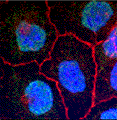Biochemistry, Department of
Document Type
Article
Date of this Version
11-2012
Citation
Jiang S, Wang W, Miner J, Fromm M (2012) Cross Regulation of Sirtuin 1, AMPK, and PPARc in Conjugated Linoleic Acid Treated Adipocytes. PLoS ONE 7(11): e48874. doi:10.1371/journal.pone.0048874
Abstract
Trans-10, cis-12 conjugated linoleic acid (t10c12 CLA) reduces triglyceride (TG) levels in adipocytes through multiple pathways, with AMP-activated protein kinase (AMPK) generally facilitating, and peroxisome proliferator-activated receptor γ (PPARγ) generally opposing these reductions. Sirtuin 1 (SIRT1), a histone/protein deacetylase that affects energy homeostasis, often functions coordinately with AMPK, and is capable of binding to PPARγ, thereby inhibiting its activity. This study investigated the role of SIRT1 in the response of 3T3-L1 adipocytes to t10c12 CLA by testing the following hypotheses: 1) SIRT1 is functionally required for robust TG reduction; and 2) SIRT1, AMPK, and PPARγ cross regulate each other. These experiments were performed by using activators, inhibitors, or siRNA knockdowns that affected these pathways in t10c12 CLA-treated 3T3-L1 adipocytes. Inhibition of SIRT1 amounts or activity using siRNA, sirtinol, nicotinamide, or etomoxir attenuated the amount of TG loss, while SIRT1 activator SRT1720 increased the TG loss. SRT1720 increased AMPK activity while sirtuin-specific inhibitors decreased AMPK activity. Reciprocally, an AMPK inhibitor reduced SIRT1 activity. Treatment with t10c12 CLA increased PPARγ phosphorylation in an AMPK-dependent manner and increased the amount of PPARγ bound to SIRT1. Reciprocally, a PPARγ agonist attenuated AMPK and SIRT1 activity levels. These results indicated SIRT1 increased TG loss and that cross regulation between SIRT1, AMPK, and PPARγ occurred in 3T3-L1 adipocytes treated with t10c12 CLA.
Included in
Biochemistry Commons, Biotechnology Commons, Other Biochemistry, Biophysics, and Structural Biology Commons



Comments
Copyright 2012 Jiang et al. This is an open-access article distributed under the terms of the Creative Commons Attribution License, which permits unrestricted use, distribution, and reproduction in any medium, provided the original author and source are credited.